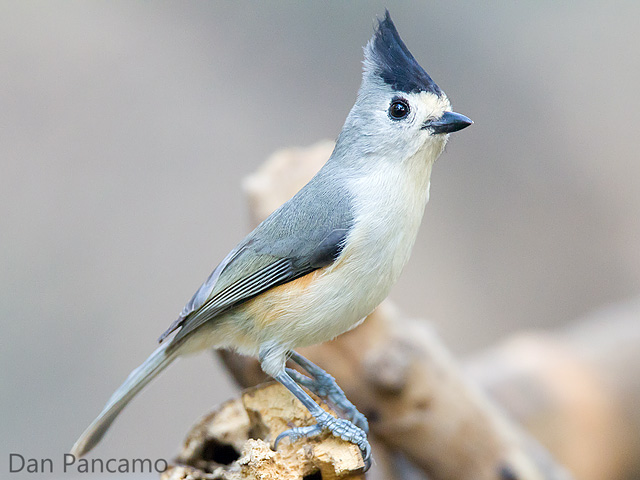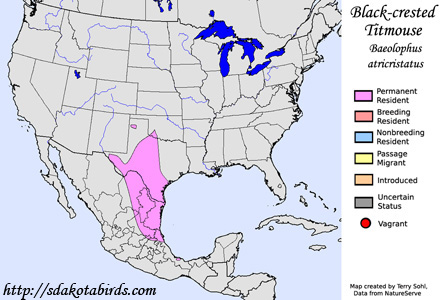| Length: 6.5 inches | Wingspan: 9.75 inches | Seasonality: Non-resident in South Dakota |
| ID Keys: Obvious large black crest, grayish overall, lighter underparts, buffy color on flanks, short stout bill | ||
 The
Black-crested Titmouse was once considered a subspecies of the
Tufted Titmouse. While similar
in overall appearance, the obvious dark crest on the Black-crested Titmouse
easily distinguishes it from the Tufted Titmouse. However, in central
Texas, the ranges of the two species overlap, and intermediate birds may
occur. They can be a quite tame species, and will readily visit
feeders in urban and suburban settings with suitable habitat in close
proximity.
The
Black-crested Titmouse was once considered a subspecies of the
Tufted Titmouse. While similar
in overall appearance, the obvious dark crest on the Black-crested Titmouse
easily distinguishes it from the Tufted Titmouse. However, in central
Texas, the ranges of the two species overlap, and intermediate birds may
occur. They can be a quite tame species, and will readily visit
feeders in urban and suburban settings with suitable habitat in close
proximity.
Habitat: Found in woodlands, scrublands, forest and forest edges, riparian areas, and in heavily forested suburban settings.
Diet: Feeds on insects and seeds. They will also feed on berries at times, and often will feed heavily on acorn crops.
Behavior: Forages by actively climbing and flitting through the canopy of a forest or shrubland, searching for insects. They may hang upside down while they forage and feed.
Nesting: The nest of a Black-crested Titmouse is built in a cavity in a tree, and consists of moss, leaves, feathers, strips of bark, or animal hair. The female lays between 5 and 8 eggs, and she alone incubates them. When the eggs hatch, the female initially stays with the young while the male gathers food for the family. The female too soon starts to gather food. The young leave the nest after about 18 days.
Interactive eBird Map: Click to access an interactive eBird map of Black-crested Titmouse sightings
Song: The song of a Black-crested Titmouse is a series of 5 to 7 slurred phrases delivered in rapid succession.
Migration: Considered a permanent resident throughout its normal range.
Similar Species: Tufted Titmouse. Also, the Juniper Titmouse has a range which barely overlaps the Black-crested Titmouse.
Feeders: Will attend feeders for sunflower seeds and suet.
Conservation Status: Populations are stable, they are found over a relatively large geographic area, and are common in parts of their range. The IUCN lists the Black-crested Titmouse as a species of "Least Concern".
Further Information: 1) AvianWeb.com - Black-crested Titmouse
2) Cornell's All About Birds - Black-crested Titmouse
3) Whatbird - Black-crested Titmouse
Photo Information: Photo taken by Dan Pancamo - December 29th, 2010 - Santa Ana National Wildlife Refuge, Texas - Photo licensed under Creative Commons Attribution ShareAlike 2.0 Generic License.
| Click below for a higher-resolution map |
 |
| South Dakota Status: Non-resident in South Dakota |
Additional Black-crested Titmouse Photos (Coming soon!)
